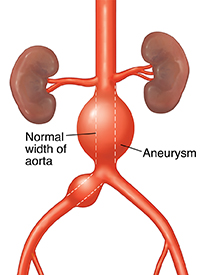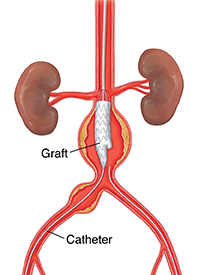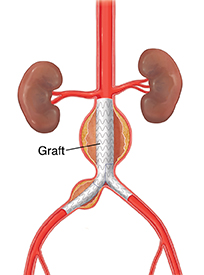Understanding Endovascular Repair of an Abdominal Aortic Aneurysm (AAA)
Endovascular repair is a type of treatment for an abdominal aortic aneurysm (AAA). An AAA is a bulge in the wall of the large artery below your heart. The large artery is called the aorta. The bulge is caused by a weak part in the artery wall. The bulge is at risk of tearing. During the procedure, the weak part of the aorta is treated to prevent it from tearing.
What is the abdominal aorta?
Your arteries are the blood vessels that bring oxygen-rich blood and nutrients to the tissues of your body. The aorta is a large artery in the body. It leads from your heart down through the inside of your chest and belly (abdomen). The part that goes through the abdomen is called the abdominal aorta.
The walls of your aorta are normally thick enough to withstand the force of the blood pressure from the heart. But some health problems can damage the walls of the aorta. This can cause a balloon-like bulge in the wall of the aorta called an aneurysm. In some cases, an aneurysm can start to split or even burst. This can often cause death. An aneurysm may also start to split along the inside of the aorta wall. This is known as aortic dissection. It can also often cause death.
Many things can damage the walls of your aorta and cause an aortic aneurysm, such as:
-
High blood pressure
-
Smoking
-
Atherosclerosis
-
Injury
-
Certain infections, such as untreated syphilis
-
Certain genetic conditions, such as Marfan syndrome
Why endovascular repair of AAA is done
You may need this procedure if your AAA is bigger than 2 inches (5 cm) or getting larger. You may also need this procedure if your AAA is at risk of splitting or bursting. Endovascular repair uses a much smaller incision than open surgery. Because of this, it has a lower risk for complications. It may help older adults who have a higher risk for complications. It can also help you recover faster.
How endovascular repair of AAA is done



A vascular surgeon or interventional radiologist and a team of specialized healthcare providers will do the surgery. Your healthcare provider will make a small cut into an artery in your groin. They will then put a thin, flexible tube (catheter) into the artery. They will gently guide the tube all the way to the aneurysm. The healthcare provider will send a stent graft along the catheter to the aneurysm. The stent graft is a tube made of a thin metal mesh (the stent), covered with a thin polyester fabric (the graft). When the stent graft reaches the aorta, the healthcare provider will open it up and fasten it in place. The stent graft will stay in place, so that blood flows through it. It protects that part of the aorta. It also keeps the aneurysm from bursting.
Risks of endovascular repair of AAA
Every procedure has some risks. The risks of this procedure include:
-
Heavy bleeding at the insertion site
-
Blood that still flows through the aneurysm bulge
-
A graft that moves, bends, or comes loose
-
Infection
-
Heart attack
-
Reaction to anesthesia
-
Reduced blood flow to the legs, intestines, or kidneys
-
Pressure in the abdomen that can damage organs (abdominal compartment syndrome)
-
The need to change to open surgery during the procedure
Your risks may vary. They depend on your age, your overall health, the size of the aneurysm, and its location. Talk with your healthcare provider to learn about your risks. Tell them about any questions or concerns you have.